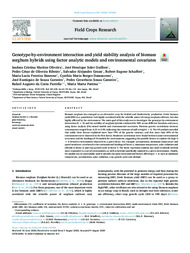Genotype-by-environment interaction and yield stability analysis of biomass sorghum hybrids using factor analytic models and environmental covariates.
Genotype-by-environment interaction and yield stability analysis of biomass sorghum hybrids using factor analytic models and environmental covariates.
Author(s): OLIVEIRA, I. C. M.; GUILHEN, J. H. S.; RIBEIRO, P. C. de O.; GEZAN, S. A.; SCHAFFERT, R. E.; SIMEONE, M. L. F.; DAMASCENO, C. M. B.; CARNEIRO, J. E. de S.; CARNEIRO, P. C. S.; PARRELLA, R. A. da C.; PASTINA, M. M.
Summary: Biomass sorghum has emerged as an alternative crop for biofuel and bioelectricity production. Fresh biomassyield (FBY) is a quantitative trait highly correlated with the calorific power of energy sorghum cultivars, but alsohighly affected by the environment. The main goal of this study was to investigate the genotype-by-environmentinteraction (G × E) and the stability of sorghum hybrids evaluated for FBY across different locations and years,using factor analytic (FA) mixed models and environmental covariates. Pairwise genetic correlations betweenenvironments ranged from -0.21 to 0.99, indicating the existence of null to high G × E. The FA analysis unveiledthat solely three factors explained more than 79% of the genetic variance, and that more than 60% of theenvironments were clustered in thefirst factor. Moderate correlations were found between some environmentalcovariates and the loadings of FA models for environments, suggesting the possible factors to explain the high G× E between environments clustered in a given factor. For example: precipitation, minimum temperature andspeed wind were correlated to the environmental loadings of factor 1; minimum temperature, solar radiation andaltitude to factor 2; and crop growth cycle to factor 3. The latent regression analysis was used to identify hybridsmore responsive to a set of environments, as well as hybrids specifically adapted to a given environment. Finally,FA models can be successfully used to identify the main environmental factors affecting G × E, such as minimumtemperature, precipitation, solar radiation, crop growth cycle and altitude.
Publication year: 2020
Types of publication: Journal article
Unit: Embrapa Maize & Sorghum
Keywords: Bioenergia, Melhoramento Genético Vegetal, Sorghum Bicolor
Observation
Some of Embrapa's publications are published as ePub files. To read them, use or download one of the following free software options to your computer or mobile device. Android: Google Play Books; IOS: iBooks; Windows and Linux: Calibre.
Access other publications
Access the Agricultural Research Database (BDPA) to consult Embrapa's full library collection and records.
Visit Embrapa Bookstore to purchase books and other publications sold by Embrapa.

